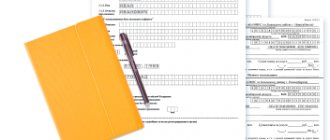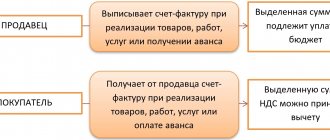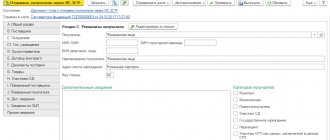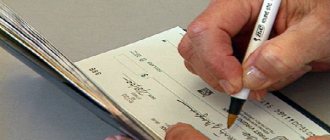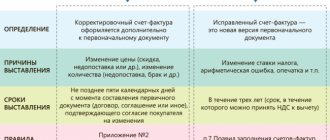Home / Taxes / What is VAT and when does it increase to 20 percent? / Book of purchases and sales
Back
Published: December 28, 2017
Reading time: 5 min
0
362
When in July 2021 new codes for transaction types came into force, used when entering data into purchase or sales books, as well as when filling out the journal of accepted and sent invoices (approved by Order of the Federal Tax Service of Russia dated March 14, 2016 N ММВ-7-3/ [email protected] ), people working in the accounting field have many questions regarding their use. Some codes have disappeared, while others were introduced for the first time and were somewhat unclear to accountants. The use of code 26, in turn, has expanded.
- Transaction type code 26 in the sales ledger: initial application
- Updated code 26 in the sales book
- The procedure for registering an entry with KVO 26 in the sales book Example of using code 26
- Important Feature
Why code the transaction type?
To find a complete list of VAT transaction type codes, you need to study:
- Appendix to the order of the Federal Tax Service dated March 14, 2016 No. ММВ-7-3/ [email protected] ;
- attachment to the letter of the Federal Tax Service dated January 16, 2018 No. SD-4-3/ [email protected] ;
- Federal Tax Service letter dated January 16, 2018 No. SD-4-3/ [email protected]
The codes are universal and are intended for use not only in the sales book (including additional sheets to it), but also:
- in the purchase book and additional lists to it;
- log of received and issued invoices.
Find out who needs to fill out an invoice journal from this material.
Order MMV-7-3/ [email protected] deciphers 24 codes (from 01 to 32), each of which indicates a specific operation related to the calculation of VAT. The shipment corresponds to codes 01 or 10 (depending on whether the goods were sold for money or transferred free of charge), code 18 is used to adjust sales.
The letter SD-4-3/ [email protected] contains codes 33-34 and 41-44, which are intended for tax agents specified in clause 8 of Art. 161 of the Tax Code of the Russian Federation (when purchasing raw hides and scrap metal). And in letter No. SD-4-3 / [email protected] - codes 37-40, recommended for use by exporters who refused the 0% rate.
The use of codes in accounting registers and reporting allows you to present information about the content of transactions in a form that is convenient:
- for use;
- transfers;
- storage;
- automatic processing.
How to indicate a product type code in a sales book if there are several such codes for a batch, see here.
In the following sections we will tell you in more detail about the most frequently used codes in the sales book in 2021.
How to indicate correctly?
In order to indicate the transaction code on the invoice correctly, you must follow the order of the Federal Tax Service indicated above.
According to it, the following encoding should be used:
- 01 – shipment of goods, performance of work or services.
- 02 – partial payment towards upcoming deliveries.
- 03 – operations performed by tax agents.
- 04 – operations free of charge.
- 05 – operations related to capital construction contracts.
- 06 – operations specified in clauses 1 – 4 of Art. 155 Tax Code of the Russian Federation.
- 07 – invoices issued by a commission agent or agent.
- 08 – return of goods.
- 09 – return of goods by individuals.
- 10 – adjustment of the invoice when the cost decreases.
- 11 – import of goods into Russia from the territory of the Eurasian Economic Community.
- 12 – import from other territories.
- 13 – restoration of tax amounts.
- 14 – return of advance payments.
- 15 – services issued using strict reporting forms.
- 16 – payments under special conditions for processing documents.
In total, the list as of April 2021 contains 16 items, each of which indicates the conditions under which the corresponding code is assigned.
Separately, it is necessary to mention code 26. It was introduced in 2015. It denoted a situation where the seller indicated in the primary product or services provided to persons who did not pay VAT (for example, those who used the “simplified system”). That is, this meant a situation where VAT was not paid at all, except in cases where the seller issued an invoice, when code 01 should be indicated.
From July 2021, code 26 in the sales ledger and invoices means something else. According to Order of the Federal Tax Service No. ММВ-7-3/ [email protected] , it is now indicated for transactions that were carried out during the accounting period in relation to persons who are on the “simplified tax” or do not pay VAT for other reasons. In addition, this code is reflected in the sales book when an advance payment is received from such persons.
Due to the fact that the list of codes changes regularly, responsible persons (managers and chief accountants of organizations, as well as individual entrepreneurs) need to constantly monitor current standards regarding coding.
Transaction type code in the purchase and sales book: 26, 21, 01 and 18, 22, 25, 26, 20, 23
Transaction code 21 in the sales book is used to reflect transactions:
- taxed at a VAT rate of 0%;
- related to the restoration of VAT.
Code 21 is used only for entries in the sales book and assumes corresponding entries of codes 01, 02, 13, 25 in the purchase book.
Example
LLC "TC "Lion"" purchases teaware from PJSC "Anaconda" for sale through its retail outlets. According to the terms of the agreement with the supplier, goods are shipped only with a 5 percent advance payment.
For each advance received, Anaconda PJSC issues an invoice to LLC Shopping Center Lyon, which the buyer registers in his purchase book with transaction type code 02 (clause 12 of article 171, clause 9 of article 172 of the Tax Code of the Russian Federation ).
Code 21 is entered in the sales book of TC Lyon LLC when teaware arrives at its warehouse - at this moment the operation to restore VAT, previously accepted for deduction on the advance invoice, is reflected.
The article “Rules for issuing invoices for advance payments in 2018 - 2021” will tell you how to issue an invoice when receiving an advance payment.
Each transaction in accounting (receipt and expense of funds) must be displayed.
For a more convenient and understandable display of transactions, special codes are used that were developed by Federal Tax Service specialists.
The main purpose of updating the code system is to simplify the administration of taxes and the processing of reports submitted by organizations and individual entrepreneurs.
Dear readers! Our articles talk about typical ways to resolve legal issues, but each case is unique.
If you want to find out how to solve your specific problem, please contact the online consultant form on the right.
(Moscow)
(St. Petersburg) It's fast and!
The transaction type code is a special code that shows the essence of the type of transaction or group of transactions carried out by a legal entity or an individual who is an individual entrepreneur. Using transaction codes in reports allows you to:
- automatically process data in the information systems of the Federal Tax Service. The role of the human factor is reduced, since people can make mistakes in calculations, and the computer will calculate and summarize all the data according to the codes. In the final purchase book or sales book, in addition to breakdowns for specific transactions, the total amount of transactions for each code will be displayed;
- transmit information in a more convenient and encrypted form;
- storing information in the 1C program.
Today, the encoding is in force, approved by the norms of the order of the Federal Tax Service of the Russian Federation dated March 14, 2021 N ММВ-7-3/136, which came into force (gained legal force) on July 1, 2016.
Their types
It is necessary to take a closer look at the essence of encodings to understand what operations can be encrypted.
Code 01 means:
- transactions for the purchase or acquisition of goods, services, intellectual property, except for transactions under certain other codes;
- payment of funds for adjustment invoices and invoices;
- entries for the refund of tax amounts that are subject to deduction or compensation to the enterprise (clause 8 of Article 145, clause 3 of Article 170, Article 171.1 of the Tax Code of the Russian Federation);
- carrying out transactions that are not subject to VAT in accordance with current legislation;
- recording the return of funds paid as an advance for goods and services (Article 171 clause 5 and Article 172 clause 6);
- payment or prepayment for the supply of goods or provision of services specified in contracts, license permits and other documents.
Code 02 records transactions to return previously purchased goods. The buyer of the goods displays this operation as an expense of material assets and a return of funds that were paid for the goods. The seller records the transaction in reverse.
The use of code 03 in the book of purchases or sales may mean the following types of transactions (according to the norms of Article 161 of the Tax Code of the Russian Federation):
- commercial activities of enterprises, companies, individuals that are not registered in the Russian Federation;
- leasing federal or municipal property in order to replenish the state or local budget;
- sale of confiscated items, treasures or property, the owner of which cannot be found.
Import codes - video topic below:
- Code 10 reflects the transfer of goods or the provision of certain types of services free of charge. We are talking about humanitarian or charitable assistance to needy individuals, organizations or states.
- Code 13 is required to be used in their reporting by those construction organizations that provide services for major repairs or modernization of real estate.
- Code 14 reflects the conduct of operations that are regulated by the norms of paragraphs 1-4 of Art. 155 of the Tax Code of the Russian Federation (assignments of monetary claims under contracts for the supply of goods or under loan agreements, transfer of rights to residential premises to new owners of these premises).
- Code 15 is used by companies to record trade relationships with sales agents who represent their companies on the basis of an agency agreement.
- If the buyer of the goods is not a VAT payer, then the transaction for the return of commodity-material value, which for one reason or another did not suit the buyer, is registered using a special code 16.
- The number 17 hides the return of goods that were purchased for money (payment in cash immediately before purchase).
- Code 18 is used in the case of fixing a corrective invoice for the following reasons: a change in the cost of goods after the previous invoice was issued, which at the time of adjustment has not yet been paid or has already been paid (additional payment or issuance of additional goods);
- change in the volume of purchased products.
- If a company purchases products or services, the actions of which are recorded in strict reporting forms, then code 23 is shown in 1C.
- Codes 24 - 28 do not reflect real trading actions (buying and selling goods).
- If cost adjustments are necessary, code 29 is used.
- Paragraphs 30 and 31 relate to recording the sale of goods that are subject to VAT payment in accordance with the provisions of Art. 151 Tax Code of the Russian Federation.
- The latest code in the current codification is 32. It is used to record transactions for accepting VAT deductions in accordance with the norms of clause 14 of Article 171 of the Tax Code of the Russian Federation.
Unused
The first time after the introduction of new codes, it is necessary to fill in both codes in the declarations. This is so that tax specialists and businessmen do not get confused by the meaning of the codes. The reason for introducing new codes is to update the VAT return.
In some cases, taxpayers forget to enter the transaction type code. The absence of codes in reporting will lead to errors in reporting, as well as:
- inability to identify a specific transaction by tax authorities;
- problems with the acceptance of reports by the Federal Tax Service.
From August 14, 2014, accountants will be required to use new forms for registering received and issued invoices, as well as purchase and sales books. They were approved by Decree of the Government of the Russian Federation of July 30, 2014 No. 735 “On amendments to Decree of the Government of the Russian Federation of December 26, 2011 No. 1137.” Let's figure out what changes legislators have made to the forms themselves and to the procedure for filling them out.
Journal of received and issued invoices
FORMS
Form of the log of received and issued invoices
Other forms
One of the main changes is that now those who are not VAT payers will also be required to keep accounting journals in the case of issuing or receiving invoices under commission, commission or agency agreements. But indicate in the journal transactions that are not subject to VAT in accordance with the provisions of Art.
The form of the magazine itself has also undergone changes.
First of all, from the first part of the journal, where issued invoices are reflected, information about the method of issuing them was removed. Let us remind you that previously it was necessary to indicate how the invoice was received: on paper or electronically. Also, for simplification, information on the number and date of issued or received adjustment, corrected and regular invoices has been combined.
But legislators also added new columns. Now you will need to provide information about your intermediary activities. They are reflected in columns 10-12 and are filled out only by a commission agent or agent carrying out business activities in the interests of another person on the basis of relevant agreements.
Thus, column 10 indicates the name of the seller (if the transaction is carried out for the principal-buyer) or the seller-committent (if the agent sells his goods). The latter’s data can be taken from column 8, part 2 of the journal. Column 11 contains the TIN and KPP of the consignor seller (data from column 9, part 2 of the journal) or the seller.
As for the invoices themselves, which must be reflected in the accounting journal, their list has also been expanded. Now it will be necessary to indicate invoices issued in cases where the commission agent or agent:
- pays in full or in part for the upcoming deliveries of goods (works, services) and the transfer of property rights to the buyer or principal (principal);
- returns to the seller the goods that were purchased for the principal (principal) and accepted by the latter for registration;
- returns to the principal (principal) the goods that were purchased for the buyer and accepted by the latter for accounting.
Similar changes occurred with the second part of the journal (“Received invoices”): they removed information about the method of issuing an invoice, combined information about the numbers and dates of issuance of regular, adjustment and corrected invoices, and added columns with data on intermediary activities, which are required to be completed by commission agents or agents.
- 1 – acquisition on one’s own behalf for the principal of goods (works, services), property rights;
- 2 – sale on one’s own behalf of goods (works, services), property rights to the buyer;
- 3 – return to the seller by the taxpayer-buyer (principal, principal) of goods accepted by him for registration in the event of the goods being purchased by a commission agent (agent) on his own behalf for the principal (principal);
- 4 – return to the seller (committent, principal) by the taxpayer-buyer of the goods accepted by him for registration in the event of the sale by the commission agent (agent) on his behalf of the goods to the buyer.
Transaction type code in the purchase book 2021
Of the 24 codes introduced by Federal Tax Service Order No. ММВ-7-3/ [email protected] dated 03/14/2016. Not everything is included in the purchase book. When filled in in the 2nd column, each invoice is encrypted with the appropriate code.
Combining several transactions in one document requires indicating the appropriate number of codes in the purchase book. Taking into account the latest amendments for 2021, the following codes are provided for the purchase book.
| Code | Name of the operation type |
| 01 | This code in the purchase book designates all transactions for the purchase of goods and materials, property rights, payment for services or work. It is used for direct and intermediary transactions and adjustment of their final amounts. All operations according to paragraphs. 2-3 p. 1 tbsp. 146, 162; clauses 3, 4, 5.1 art. 154, paragraphs. Clause 3 art. 170 Tax Code of the Russian Federation |
| 02 | Code 02 is intended for processing received prepayment against future shipments. This includes operations under agency and commission agreements, transport forwarding services. |
| 16 | The purpose of the code is to process the return of goods from buyers who do not pay VAT. This refers only to legal entities. It is entered into the purchase book in the event of termination of the transaction and the return of the advance payment to the buyer with the issuance of a corresponding return invoice. |
| 17 | Similar to code 16 with a difference in buyer status - only for individuals. Used to process returns to individual customers. |
| 18 | The 18th code accompanies transactions issued with an adjustment invoice. If you change the previously specified shipping cost, this code allows you to correctly calculate VAT. The cost adjustment is due to a change in the quantity of the product or its price. |
| 19 | In the purchase book, goods imported from the EAEU countries are registered with code 19. |
| 20 | The twentieth code records transactions involving the import of goods into the Russian Federation from countries outside the EAEU. |
| 22 | They issue a refund of the advance payment, on which VAT has already been charged. The basis is changes in the terms of cooperation or its complete termination. It is also used to register shipment according to the advance payment previously listed and reflected in accounting. |
| 24 | For invoices that meet the requirements of clause 9 of Art. 165 and paragraph 10 of Art. 171 Tax Code of the Russian Federation. Purpose – reflection of VAT deduction at the 0th rate. |
| 25 | To restore tax at the 0th rate and transactions corresponding to clause 7 of Art. 172 of the Tax Code of the Russian Federation - for goods and services with a production cycle of more than six months. |
Similar articles
- Transaction type code in the sales book 2018
- Transaction code in the VAT return
- Transaction type code in the sales book 2018
- Transaction type code in the 2021 purchase book
- Operation type code 2018
Similar articles
- Operation type code 2018
- Transaction code in the VAT return
- Transaction type code in the sales book 2018
- Transaction type code in the sales book 2018
- Transaction type code in the 2021 purchase book
VAT return: transaction type code
We bring to your attention an article by Nadezhda Turusova, head of the desk audit department of the Federal Tax Service of Russia for the Sverdlovsk region, published in the magazine “I am an accountant”.
Using the type of transaction code, the Federal Tax Service identifies a specific business transaction, compares the data of counterparties and establishes the legality of the presented deduction.
If the code is specified incorrectly, difficulties may arise when submitting the declaration, and errors and discrepancies may arise when reconciling the data of buyers and sellers in the information system of the Federal Tax Service of Russia.
The procedure for applying transaction type codes (KVO) for VAT is regulated by Federal Tax Service order No. ММВ-7-3 dated February 14, 2012 / [email protected]
Also in 2015, additional codes were introduced (see letter from the Ministry of Finance and the Federal Tax Service of Russia dated January 22, 2015 No. GD-4-3 / [email protected] ).
The appendices to the documents provide a table of the types of operations and the codes that correspond to them.
However, in practice, many situations are difficult to classify or can be classified into two types of operations at once. For example, neither from the order of the Federal Tax Service of Russia, nor from the letter is it clear that code 01 must be used for export operations.
This can only be clarified after consultation with the Federal Tax Service. In another case, the company restored the amount of tax on transactions for the purchase of goods on the basis of a commission agreement.
Which code to use: 04 - as for transactions with intermediaries or 21 - as for VAT recovery?
It is even more difficult to figure out which fields in the purchase book and sales book and how exactly should be filled in when choosing one or another KVO.
For example, if you use code 26, you don’t have to indicate the TIN/KPP of the selling organization.
We'll tell you how to apply the QUO and register invoices for those business transactions that raise the most questions for accountants.
06: Operations performed by tax agents listed in Art. 161 Tax Code of the Russian Federation.
Applicability: purchase ledger and sales ledger.
- The taxpayer acts as a tax agent for the payment of VAT for foreign persons (clause 2 of Article 161 of the Tax Code of the Russian Federation) when leasing state property (clause 3 of Article 161 of the Tax Code of the Russian Federation), when selling confiscated property, etc. (clause 4 of Article 161 of the Tax Code RF), as well as when carrying out activities in the interests of a foreign organization with participation in settlements (clause 5 of Article 161 of the Tax Code of the Russian Federation). At the time of tax calculation (for transactions provided for in clauses 2, 3 of Article 161 of the Tax Code of the Russian Federation) or receipt of payment (clauses 4, 5 of Article 161 of the Tax Code of the Russian Federation), an invoice is issued and entered into the sales book with this code.
- To receive a deduction, this invoice is registered in the purchase book with the same code only for transactions provided for in clauses 2, 3 of Art. 161 Tax Code of the Russian Federation.
- In the “TIN/KPP buyer” field in the sales book, you must indicate the details of your organization.
- In the field “TIN/KPP of the seller” in the purchase book, you need to indicate dashes for the transactions provided for in clause 2 of Art. 161 Tax Code of the Russian Federation; details of the real seller company, for which the tax agent provided for in paragraph 3 of Art. 161 of the Tax Code of the Russian Federation, fulfills the obligation to pay tax.
19: Import of goods into Russia and other territories under its jurisdiction from the territory of the Eurasian Economic Union.
Applicability: purchase book.
The code is used when importing goods from the EAEU countries after paying VAT in the manner prescribed by Section 3 of Appendix No. 18 to the Treaty on the Eurasian Economic Union dated May 29, 2014 (EAEU Treaty).
In the “Invoice number” field, you must indicate the registration number of the application for the import of goods and payment of indirect taxes from section 2 of the application (see Appendix 1 to the Protocol dated 11.12.
2009 “On the exchange of information in electronic form between the tax authorities of the EAEU member states on the paid amounts of indirect taxes” as amended. dated December 31, 2014).
The number is displayed in the format NNNNDDDMMYYYYXXXX (16 characters), where
- NNNN (1–4 characters) - code of the tax authority that assigned the registration number;
- DDMMYYYY (5–12 characters) — date of registration of the application;
- XXXX (13–16 characters) — serial number of the registration record during the day.
20: Import of goods into Russia and other territories under its jurisdiction (customs procedures for release for domestic consumption, processing for domestic consumption, temporary import and processing outside the customs territory), except for import from the countries of the Eurasian Economic Union (EAEU Treaty dated May 29, 2014) .
In the “Invoice number” field, you must indicate the details of the declaration of goods from column 7 of the main sheet of the declaration of goods (DT). They are reflected in the format XXXXXXXX/YYYYYY/ZZZZZZZ (8 characters, 6 numbers, 7 symbols), where
- XXXXXXXX (1–8 characters) - customs authority code established by the Federal Customs Service of Russia;
- YYYYYY (9–14 characters) — date of filing the declaration (day, month, last 2 digits of the year);
- ZZZZZZZ (15–21 characters) — serial number of the declaration.
23: Purchase of services issued with strict reporting forms in the cases provided for in paragraph 7 of Art. 171 Tax Code of the Russian Federation.
In the field “TIN/KPP of the seller” you must indicate the details of the real seller.
The code applies to operations that are listed in clause 7 of Art.
171 of the Tax Code of the Russian Federation, namely: travel expenses to and from the place of business travel, including expenses for the use of bedding on trains, expenses for renting living quarters, as well as entertainment expenses.
It is extremely important to register transactions using strict reporting forms with code 23. It provides that for such a transaction the details of not the invoice, but the corresponding check will be indicated.
26: Drawing up primary accounting documents for the sale of goods (work, services), property rights to persons who are not VAT payers, as well as to taxpayers exempt from the duties of calculating and paying tax.
Applicability: sales book.
The code is used for sales to individuals, organizations and individual entrepreneurs who apply special tax regimes and are exempt from the duties of a VAT payer in accordance with Art. 145, 145.1 Tax Code of the Russian Federation.
The “Buyer’s INN/KPP” field is not filled in.
The peculiarity of registering a transaction with such persons is to use the code that is provided for such situations - 26.
In both cases, an error will appear at the format-logical control stage.
What changes in the VAT transaction type codes from July 1, 2021
Document
Order of the Federal Tax Service of Russia dated March 14, 2016 No. ММВ-7-3/ [email protected]
A comment
On April 25, 2021, the order of the Federal Tax Service of Russia dated March 14, 2016 No. ММВ-7-3/ [email protected] “On approval of the list of codes for types of transactions indicated in the purchase book used in calculations of value added tax” was published on the official website of legal information. an additional sheet to it, a sales book used in calculations for value added tax, an additional sheet to it, as well as codes for the types of transactions for value added tax necessary for maintaining a log of received and issued invoices" (registered with the Ministry of Justice of Russia 04/20/2016 No. 41876) (hereinafter referred to as Order No. 136).
The new order comes into force on July 1, 2021. From this date, the order of the Federal Tax Service of Russia dated February 14, 2012 No. ММВ-7-3/ [email protected] “On approval of codes for types of transactions for value added tax necessary for maintaining a log of received and issued invoices” (registered in Ministry of Justice of the Russian Federation on March 21, 2012 No. 23546) (hereinafter referred to as Order No. 83), taking into account the additions made by the letter of the Federal Tax Service of Russia dated January 22, 2015 No. GD-4-3/ [email protected] “On the procedure for applying codes for types of VAT transactions” ( hereinafter referred to as Letter No. 794).
The basis of new codes for types of operations, approved. Order No. 136 laid down the previously used codes, for which a regrouping was carried out and clarifications were made to the descriptions. In addition, new codes were approved in connection with amendments made to the Tax Code of the Russian Federation regarding the taxation of transactions in the territory of the Special Economic Zone in the Kaliningrad Region.
| Codes | New codes (approved by order of the Federal Tax Service of Russia dated March 14, 2021 No. ММВ-7-3/136) | Previous codes (approved by order of the Federal Tax Service of Russia dated February 14, 2012 No. ММВ-7-3/83) |
| 01 | Code 01 is still used when shipping (transferring) or purchasing goods (work, services, property rights). But the list of situations when it should be used has expanded. It includes the following situations:
Code 01 is not used for operations for which codes 06 are provided; 10; 13; 14; 15; 16; 27 | Code 01 has previously been used for the shipment (transfer) or acquisition of goods, work, services, and property rights. However, code 01 was not used in the following situations:
Code 01 was not used for operations for which codes 03, 04, 06, 10, 11, 13 are provided |
Code 01 is still used:
| ||
| 02 | Code 02 is still used for payment, partial payment (received or transferred) for upcoming deliveries of goods (performance of work, provision of services, including intermediary services), transfer of property rights. Now code 02 is also used if an advance has been received or transferred:
| Code 02 has previously been used for payment, partial payment (received, transferred) for upcoming deliveries of goods (work, services, including intermediary services), transfer of property rights. Previously, code 02 was not used if an advance was received or transferred:
|
| Code 02 is still not used in situations for which codes 28 and 06 are provided | ||
| 03 | Code 03 is excluded from the list | Previously, code 03 was used by both sellers and buyers when returning goods. Exceptions – receipt by the seller of goods returned by a buyer who is a VAT defaulter (code 16) and an individual who paid for the purchase in cash (code 17) |
| 04 | Code 04 is excluded from the list | Previously, code 04 was used by both customers and intermediaries in commission agreements and agency agreements, if the intermediary acted on his own behalf. Exceptions - intermediary services (code 01) and VAT transactions of tax agents listed in Article 161 of the Tax Code of the Russian Federation (code 06) |
| 05 | Code 05 is excluded from the list | Previously, code 05 was used by intermediaries when receiving (transferring) advances under commission agreements and agency agreements, in which intermediaries act on their own behalf. Exceptions - intermediary services (code 02) and operations of tax agents listed in Article 161 of the Tax Code of the Russian Federation (code 06) |
| 06 | Code 06 is still used by VAT tax agents (Article 161 of the Tax Code of the Russian Federation). It has been clarified that code 06 also applies in cases where the tax agent has entered into an intermediary agreement with the taxpayer. Additionally, there are now two exceptions. Code 06 is not used when selling property:
| Previously, tax agents used code 06 in all situations listed in Article 161 of the Tax Code of the Russian Federation. Including when selling property:
|
| 07 | Code 07 is excluded from the list | Previously, code 07 was used by VAT payers when transferring for their own needs goods, works, services, the costs of which are not taken into account when taxing profits (subclause 2, clause 1, article 146 of the Tax Code of the Russian Federation) |
| 08 | Code 08 is excluded from the list | Previously, code 08 was used by VAT payers when performing construction and installation work for their own consumption (subclause 3, clause 1, article 146 of the Tax Code of the Russian Federation) |
| 09 | Code 09 is excluded from the list | Previously, code 09 was used when receiving amounts related to payment for goods (work, services) sold (Article 162 of the Tax Code of the Russian Federation). In particular, upon admission:
|
| 10 | Code 10 is still used by those who transfer (ship) goods (work, services, property rights) free of charge. | |
| 11 | Code 11 is excluded from the list | Previously, code 11 was used:
|
| 12 | Code 12 is excluded from the list | Previously, code 12 was used when receiving (transferring) an advance on account:
|
| 13 | Code 13 is used by contractors, developers, building customers, technical customers who:
This code is also used by investors who purchase such works | Code 13 has previously been used by contractors (developers, technical customers) for capital construction and modernization (reconstruction) of real estate. Including when registering invoices received from contractors (letter of the Federal Tax Service of Russia dated July 20, 2015 No. ED-4-3/12764) |
| 14 | Code 14 is used when transferring property rights, which are specified in paragraphs 1–4 of Article 155 of the Tax Code of the Russian Federation. In particular, when:
| Previously, code 11 was used in these cases |
| 15 | This is new code. Code 15 is used by commission agents and agents when they prepare or receive invoices that reflect:
| Previously there was no code 15. In these situations, code 04 or code 05 was used |
| 16 | Code 16 is still used by sellers when buyers who do not pay VAT return goods previously purchased from them. | |
| 17 | Code 17 is used by sellers when:
| Previously, code 17 was provided only for the situation when the goods are returned by the buyer - an individual who paid in cash |
| 18 | Code 18 is still used by sellers and buyers when they reduce the cost (quantity, volume) of goods sold (work, services, property rights). Basis – adjustment invoice | |
| 19 | Code 19 is still used when importing goods into Russia from the states of the Eurasian Economic Union (EAEU). These countries include Belarus, Kazakhstan, Armenia and Kyrgyzstan | |
| 20 | Code 20 is still used when importing goods into Russia from abroad (except for EAEU countries) in customs procedures:
| |
| 21 | Code 21 is still used when VAT is restored in cases listed in paragraph 8 of Article 145, paragraph 3 of Article 170, and Article 171.1 of the Tax Code of the Russian Federation. This code is also used for transactions that are subject to VAT at a rate of 0 percent | |
| 22 | Code 22 still applies when the seller:
| |
| 23 | Code 23 is still applied if the buyer accepts for deduction of VAT on travel expenses confirmed by strict reporting forms. For example, air and railway tickets (including electronic ones) or hotel bills (clause 7 of Article 171 of the Tax Code of the Russian Federation) | |
| 24 | Code 24 is still used when deducting input VAT on goods (work, services) that are used for an unconfirmed export transaction (paragraph 2, paragraph 9, article 165 and paragraph 10, article 171 of the Tax Code of the Russian Federation) | |
| 25 | Code 25 is still used when registering invoices for which the submitted VAT was accepted for deduction and then reinstated due to the fact that the organization used purchased goods (work, services, property rights) in transactions subject to VAT at a rate of 0 percent | |
| 26 | Code 26 is still used if an invoice and primary documents have been prepared for buyers who do not pay VAT or for buyers who apply VAT exemption under Article 145 of the Tax Code of the Russian Federation. It has been established that code 26 applies, among other things, if buyers:
| Code 26 was previously used if an invoice and primary documents were prepared for buyers who do not pay VAT or for buyers who apply VAT exemption under Article 145 of the Tax Code of the Russian Federation. There were clarifications that code 26 is used when registering invoices on the basis of which VAT was accepted for deduction and then restored in connection with the use of acquisitions in transactions subject to VAT at a zero rate (clause 23.2 of section II of appendix 4 to the resolution Government of the Russian Federation dated December 26, 2011 No. 1137, letter of the Federal Tax Service of Russia dated June 26, 2015 No. GD-4-3/11145) |
| 27 | Code 27 is still used by intermediaries and customers when registering consolidated invoices in the cases listed in paragraph 3.1 of Article 169 of the Tax Code of the Russian Federation. For example, when selling goods (works, services, property rights) under commission agreements and agency agreements on behalf of intermediaries | |
| 28 | Code 28 is still used by intermediaries and customers when registering consolidated invoices for advances in cases from paragraph 3.1 of Article 169 of the Tax Code of the Russian Federation. For example, under commission agreements and agency agreements on behalf of intermediaries | |
| 29 | Code 29 is a new code. It is used in transactions between interdependent persons - when adjusting the sale of goods (work, services, property rights), an enterprise as a property complex (clause 6 of Article 105.3 of the Tax Code of the Russian Federation) | There was no code 29 before. There was no clarification on which code to use when making adjustments to transactions between related parties |
| 30 | Code 30 is a new code. It is used when shipping goods on which VAT has been charged at customs under paragraph 1 of subparagraph 1.1 of paragraph 1 of Article 151 of the Tax Code of the Russian Federation (in the free customs zone on the territory of the SEZ in the Kaliningrad region) | There was no code 30 before |
| 31 | Code 31 is a new code. It is used when shipping goods on which VAT has been charged at customs under paragraph 2 of subparagraph 1.1 of paragraph 1 of Article 151 of the Tax Code of the Russian Federation (in the free customs zone on the territory of the SEZ in the Kaliningrad region) | There was no code 31 before |
| 32 | Code 32 is a new code. It is used when shipping goods on which VAT has been charged at customs under paragraph 14 of Article 171 of the Tax Code of the Russian Federation (in the free customs zone in the territory of the SEZ in the Kaliningrad region) | There was no code 32 before |
| 99 | There is no code 99 anymore. When purchasing goods (work, services) from sellers who are registered in Crimea or Sevastopol, as a general rule, code 01 is used | Previously, buyers used code 99 when registering tax invoices received from sellers from Crimea or Sevastopol in the purchase book (letter of the Federal Tax Service of Russia dated April 7, 2015 No. GD-4-3/5757) |
Nuances of using code 26 in 2019
The sales book records the number and date of preparation of the sales form or other form indicating the fact of sale, the price with and without VAT, as well as the actual amount of VAT. In this case, the column “TIN/KPP of the buyer” remains blank. A counter entry about the SF in the purchase book (return of goods, advance payment) can be encrypted with codes 16, 17 or 22.
In contrast to transactions encrypted with code 26, when recording other sales, filling in the “TIN/KPP” line is mandatory, since such an oversight will certainly be detected during format and logical control.
The company, which trades wholesale and retail, in November 2021 sold goods to individuals, including VAT, in the amount of RUB 7,000,000, including in cash - RUB 3,000,000, by bank cards - RUB 4,000,000 .
The company has the right not to issue a tax return for each sale for cash (clause 7 of article 168 of the Tax Code). In the sales book there are transactions in the amount of 3,000,000 rubles. will be reflected under code 26 based on cash register data - in column 7 the category of buyers “individual” will be indicated, and in column 8 “TIN/KPP” the accountant will make dashes.
For the category of buyers using payment cards, at the end of the reporting period the seller will have to draw up a general SF, since a transfer from a card is considered a non-cash form of payment (Article 3 of Law No. 161-FZ of June 27, 2011; Clause 3 of Article 168 of the Tax Code). In this case, operations totaling RUB 4,000,000. are also encoded with code 26, but on the basis of a consolidated SF drawn up in one copy.
It will be necessary to record code 26 in the sales book if the company sold work and (or) services during the reporting period:
- persons who are not VAT payers (for example, individuals);
- firms and individual entrepreneurs who are exempt from VAT.
Code 26 is also applied in cases where an advance payment has been received from the above persons for subsequent shipments (performance of work, provision of services).
Entries in the sales book under code 26 are made on the basis of summary documents (invoices, cash register control tape (Z-report), BSO).
The introduction of the mandatory use of online cash registers for most taxpayers makes certain adjustments to the process of filling out the sales book.
If a taxpayer sells goods for cash using modern cash registers (online cash registers), the basis for recording transactions in line with code 26 in the sales book in 2021 can no longer be a Z-report (final report for cash registers equipped with EKLZ) . This is due to the fact that the EKLZ is not available in the online cash register (replaced by a more advanced memory module - a fiscal drive).
What replaces the Z-report in online cash registers, see the article “Do I need a z-report when using an online cash register?”
Example
LLC "TC Lyon" trades wholesale and retail. In April 2019, it sold tea utensils to its customers - individuals.
Since the company trades at retail for cash, it has the right not to issue invoices for each sale (Clause 7 of Article 168 of the Tax Code of the Russian Federation).
An entry in the sales book under code 26 of TC LLC is made on the basis of the cash register control tape. At the same time, in column 7 “Name of the buyer” a generalized group of buyers is reflected - individuals, and in column 8 “TIN/KPP of the buyer” a dash is entered.
If individual buyers pay with bank cards, the seller (Shopping Center Lyon LLC) must issue an invoice, since this form of payment is recognized as non-cash (clause 3 of Article 168 of the Tax Code of the Russian Federation).
In this situation, an entry in the sales book will also be made using code 26, but the basis for it is a consolidated invoice - it can be issued in one copy based on the results of the tax period (letter of the Ministry of Finance of Russia dated April 1, 2014 No. 03-07-09/14382 ).
Implementation adjustment (code 18)
The basis for recording an entry with transaction type code 18 in the sales book is an adjustment invoice issued by the seller to the buyer when the cost of shipped goods (work, services) is reduced.
The cost of sales may decrease, for example, if:
- price (tariff) of the product;
- quantity (volume) of delivery.
All cases and conditions for issuing an adjustment invoice are in our material “What is an adjustment invoice and when is it needed?”
Example
PJSC Anaconda issued in June 2021 to its buyer LLC TC Lyon an adjustment invoice for last month's shipment. The decrease in the cost of sales for it amounted to 289,000 rubles. (including VAT RUB 44,084.75).
Both counterparties to this transaction will apply transaction type code 18 in the following order:
- LLC "TC Lyon" (buyer) will register the received CSF in the sales book in the amount of 289,000 rubles. (including VAT RUB 44,084.75);
- PJSC "Anaconda" (seller) will reflect its copy of the CSF in the purchase book for the same amount.
What does code 03 mean?
Code 03 has been canceled since 2021 - in order MMV-7-3 / [email protected] there is no such code for the type of operation. Until July 1, 2016, this code was used to reflect:
- return of goods to the seller by the buyer;
- receipt by the seller of goods returned by the buyer.
For details on the nuances of paperwork and VAT accounting in the situation of returning goods, see the material “What is the procedure for accounting for VAT when returning goods to a supplier?”
Instead of the eliminated code 03, 3 other codes are currently used:
- 01 - the goods were returned by the VAT payer;
- 16 - the goods were returned by a company or individual entrepreneur who does not pay VAT;
- 17 - the goods were returned from the individual.
If you indicate an invalid code 03 in the sales book, this will be considered an error. In addition, difficulties may arise for both the tax authorities and the taxpayer (more on this later).
What consequences may occur if the transaction type code is not in the sales book?
The VAT return is provided to tax authorities only in electronic form, and information from the sales book is included in it as a separate section. Therefore, an error in the sales book automatically means an error in VAT reporting.
Absence of codes or their incorrect indication in the “Operation type code” column of the sales book:
- for tax authorities - it will not allow you to identify a specific business transaction, compare it with the data of counterparties and justify the legality of the deduction;
- for the taxpayer - will create problems with filing a VAT return (a report without codes may not be missed by the program of the special operator through whom the electronic declaration is received by the tax authority) and will cause a refusal to deduct the value added tax.
Incorrect codes may lead to discrepancies with counterparty data and will require additional explanations upon requests from controllers.
To correctly indicate codes in the sales book, it is necessary not only to correctly classify the operation and control the correct completion of column 2 in the sales book, but also to regularly monitor changes in legislation on this issue.
The procedure for registering an entry with KVO 26 in the sales book
The book of purchases and sales is filled out by companies and individual entrepreneurs who are payers on the OSN based on the issued invoices. These documents reflect almost all the data that is required for maintaining tax accounting forms and is reflected in the VAT return.
In the purchase book, the value of the type of transaction is written in column 2. This rule also applies to accounting for sales. The list was approved by order of the Federal Tax Service. There are 24 numbers in total, but they are not numbered in continuous order. The last one on the list is “32”. Each of the values reflects a separate situation that is related to the calculation of the payment. Some figures can be used for the purchase and sales ledger.
Indicator 26 in sales accounting is used to indicate the preparation of a consolidated tax return, which contains data on the sale of goods, works and services for persons who are not payers of the fee. The same number is used when receiving advance payment from these persons.
It is important to correctly display the figures for the type of transactions in VAT accounting forms. This is due to the fact that the Federal Tax Service analyzes the data provided by payers, including by numbers. To reduce the number of errors, the Federal Tax Service has issued clarifications regarding existing QUOs
